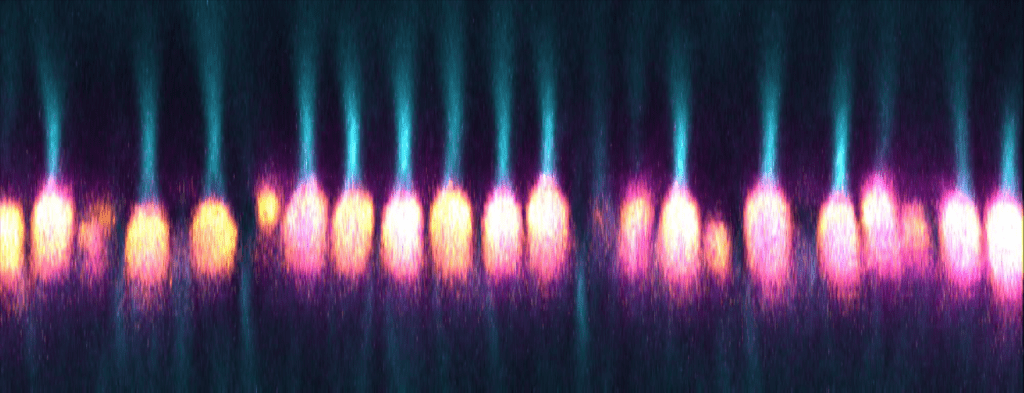Mitochondria (the famous powerhouses of the cell) seem to perform a double function in vision. A new study found that mitochondria can act as ‘microlenses’ to redirect light in the eye, allowing it to be converted into electrical signals to the brain — playing a major, previously unknown, part in our sight.

Your eyes need a lot of energy
Mitochondria perform a number of critical tasks inside the retina — the thin layer of tissue that lines the back of the eye on the inside. One of these tasks involves providing massive amounts of energy to retinal neurons to generate membrane potentials that must traverse the brain’s vast interwoven optical tracts.
This comes at a cost, and unfortunately, this large expenditure of energy leaves mitochondria in the eye’s retina incredibly susceptible to damage with many age-related retinal diseases, including glaucoma and age-related macular degeneration, associated with mitochondrial dysfunction.
However, researchers assumed this was solely down to the loss of power to the cells – but now a new study has identified another critical role for mitochondria in eyesight.
Researchers at the National Eye Institute (NEI) say the multi-tasking mitochondria are in the back of the eye in the retina’s cone receptor cells — the cells responsible for color vision. The mitochondria power sight and direct light from the pupil to these cells’ outer segments where it’s converted into nerve signals. The findings, published in Science Advances, provide more clarity regarding the evolution of vision and the uncertainty surrounding the retina’s physiology and disease pathology.
“We were surprised by this fascinating phenomenon that mitochondria appear to have a dual purpose: their well-established metabolic role producing energy, as well as this optical effect,” says lead study author Wei Li, head of the NEI’s retinal neurophysiology section.”
The findings also address a long-standing mystery surrounding the mammalian retina and its role in transporting light signals to the brain. In their paper, the group explains that once the photons of light arrive at the retina, they must pass through multiple neural layers before reaching the outer segment of photoreceptors to be converted into nerve signals. Researchers previously thought that these signals must traverse an unusually dense bundle of mitochondria in the cone and rod receptor cells before moving from the inner to the outer segment of these cells on their way to the brain.
But although it might appear these mitochondria work against the path of vision by either scattering or absorbing light, the current study shows they serve a unique function to improve and facilitate vision.
The unique eyes of the ground squirrel
To prove this, Li’s team investigated the role of mitochondria in cone photoreceptors in the 13-lined ground squirrel. The group used these animals in the study as their retina comprises mainly cones, containing far more mitochondria than rod cells. Ground squirrels also hibernate, allowing the inspection of live lipid-rich mitochondria after extraction from the animal’s eyes – providing more accuracy.
Using a modified confocal microscope to observe the living cone mitochondria exposed to light, the researchers said that instead of scattering the beams, the tightly packed mitochondria act as mini lenses to direct the effulgence onto the light-sensitive outer edge of the cells. High-resolution computational modeling verified that these organelles were using a process known as the Stiles-Crawford effect to optimize converted electrical signals to the brain by focusing light into the outer segment of the cells containing them.
This mechanism is where light enters the center of the pupil to produce more of a response in our cone cells than light entering closer to the edge. Until now, it was unknown that mitochondria acting as microlenses were the reason this emanation was causing such a blazing response in the eye’s photoreceptors. Adding this discovery may also provide new targets to treat mitochondrial-based retinal disease.
Humans and insects are more alike than you think
The study also sheds further light on the evolution of mammalian eyes. The team posits that oil droplets found in the photoreceptors of birds and reptiles may play a role similar to that of the lipid-rich mitochondria found in the cones of ground squirrels.
Furthermore, they say mitochondrial microlens in mammalian cone cells may confer a functionality similar to that witnessed in the eyes of invertebrates such as flies and bumblebees, although this still needs to be further investigated. Nonetheless, non-primate cone morphology is typical among vertebrates that lack oil droplets in their eye; therefore, it stands they must rely on fatty mitochondria to produce the Stiles-Crawford effect. Li says:
“This insight conceptually bridges compound eyes in arthropods with the camera eyes of vertebrates, two independently evolved image-forming systems, demonstrating the power of convergent evolution.”
The team now intends to explore how structural and functional changes in cone mitochondria affect vision through modeling and the countless animal models this discovery has provided.









